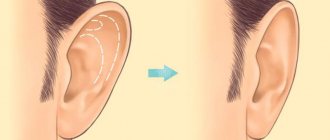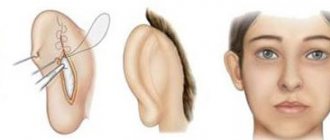“I would like to change the shape of my ears, get rid of protruding ears” is perhaps one of the most common wishes addressed to a plastic surgeon. Is it possible? It's certainly possible. Currently, plastic surgeons have techniques in their arsenal that allow them to correct any type of protruding ears. However, the patient must decide for himself whether he needs otoplasty before making an appointment with the surgeon.
The main question during the consultation should not be: “Do I need surgery, doctor?”, but “Is it possible to get the desired shape of the ears?” and “Which otoplasty method is optimal in my case?”
Indications for otoplasty:
- protruding ears (protruding ears);
- ear defects;
- asymmetry of the ears.
The operation was performed by M.V. Larionov. Clinic "Giannis" |
When practicing otoplasty in Kazan, we use a “seamless” technique, in which the necessary correction of the shape of the auricle is achieved not by tightening sutures, which can cut through over time, but by modeling the cartilage using special notches. The final result, which we evaluate 1.5 months after the operation, remains for life - the possibility of spontaneous restoration of the previous shape of the shells is excluded, which is confirmed by numerous reviews of otoplasty in Kazan and other cities performed using this technique. The operation is performed under local anesthesia and after its completion the patient goes home.
Subsequently, the healing of postoperative wounds is monitored during dressing changes. The patient's social activity is not limited; work and study can continue.
Despite the current opinion that correction of protruding ears is not at all necessary, our experience shows that eliminating this problem makes patients a little happier and our work more enjoyable.
How is the operation performed?
Before performing otoplasty, it is necessary to undergo general clinical tests to identify contraindications.
If none are found, our doctors, together with the patient, plan the operation and set its exact date. The specific method for correcting the shape and size of the auricle, on which the cost of otoplasty also depends, is chosen by surgeons individually, guided by their professionalism and practical experience. This choice is also influenced by the structural features of the auricle in a particular patient. But almost always, surgical incisions are made along the back walls of the auricle and behind the ears. Thus, postoperative scars will be almost completely hidden from view of others.
In our clinic, otoplasty is most often performed using local anesthesia and is easily tolerated by patients. In young children, general anesthesia can also be used.
If the purpose of the operation is to correct the shape of the auricle or protruding ears, the surgeon excises the tissue, fixes the cartilage in a new position relative to the head and gives it new contours. If the operation is reconstructive, aimed at restoring a partially or completely lost ear concha, then the patient’s own cartilage tissue is taken for transplantation. This completely eliminates the risk of rejection of the transplanted material. The total duration of otoplasty is on average 30-60 minutes.
Otoplasty: prices
Prices for otoplasty in Kazan - laser and scalpel - at the Giannis clinic depend on the age of the patient, as well as the characteristics of the clinical case.
The patient can obtain more detailed information about the features of ear correction techniques used at the Giannis clinic, as well as find out the exact prices for surgery to eliminate protruding ears during a consultation.
Our plastic surgeons:
- Zhanna Iskanderovna Kuznetsova
- Mikhail Viktorovich Larionov
Operation stages
Anesthesia
The operation takes place under local anesthesia and lasts from forty minutes to one and a half hours. The procedure is simple and therefore does not require general anesthesia.
A small incision is made behind the ear
The surgeon removes excess ear cartilage, forms a new anatomical shape of the auricle and its correct position. The duration of the operation is from forty minutes to one and a half hours.
The incision is sutured with self-absorbing threads
There are no visible traces of the operation left.
Earlobe plastic surgery
Sometimes, along with otoplasty, correction or restoration of the shape of the lobe is performed. Then the operation lasts about another half hour to an hour. Easily tolerated by the patient.
Applying a bandage
A bandage is applied to the ears, providing fixation and protection from damage. Since the operation is performed on an outpatient basis, the patient does not need to be in the hospital. You can go home the same day.
Laser otoplasty
A more modern way to eliminate ear shape defects is laser otoplasty. The laser beam acts as an alternative to scalpel surgery. The laser is able to cut through tissue and act on cartilage, modifying its shape and thereby correcting the shape of the ears.
Traditional scalpel surgery is inferior to laser otoplasty for a number of factors:
- The operation is carried out in a contactless manner, because cuts are made with a laser beam;
- the laser is able to glue the walls of blood vessels, reducing the risk of blood loss (coagulation ability);
- cartilage tissue, heated by a laser beam, becomes plastic. The auricle can be easily given the desired shape;
- after laser surgery there is much less swelling and bruising for the patient;
- infection is excluded, since the laser beam completely disinfects the tissue during correction;
- With the help of a laser, barely noticeable cuts are made, all manipulations are carried out with perfect precision;
- the appearance of scars after surgery is excluded;
- Tissue healing after laser correction occurs much faster, in contrast to traditional surgery. Laser radiation stimulates regenerative processes in tissues;
- Laser surgery helps reduce pain from the intervention, as well as shorten the rehabilitation period.
Types of plastic surgery
Plastic surgeries can be divided into two main types - reconstructive and aesthetic.
Reconstructive plastic surgeries help eliminate deformations, defects of tissues and organs, and restore their functions using plastic surgery methods. These surgeries are performed on people who have suffered physical injury due to injury, illness, or birth defects. Successful reconstructive surgery can radically change a person's quality of life, helping them regain a sense of full life.
Aesthetic plastic surgery is the use of plastic surgery techniques to improve appearance. Thanks to such operations, people can not only prolong their youth and feel their beauty, but also get rid of the emotional stress of realizing their real or imagined imperfections, and thereby also significantly improve their quality of life.
We may have heard of some types of aesthetic surgeries on television or from friends; roughly speaking, they are well known and have considerable popularity. Such operations can be classified by area of execution:
- facial rejuvenation (rhytidectomy, facelift)
- brow and forehead lift (front lift)
- eyelid surgery (blepharoplasty)
- nose surgery (rhinoplasty, septoplasty)
- plastic surgery of the ears (otoplasty)
- lip plastic surgery (cheiloplasty)
- hair transplantation
- chin plastic surgery (mentoplasty, mandibuloplasty or genioplasty)
- cheekbone plastic surgery (malarplasty)
- plastic surgery of the neck and submental area (cervicoplasty)
- breast plastic surgery (mammoplasty)
- tummy tuck (abdominoplasty, liposuction)
- plastic surgery of the buttocks (gluteoplasty)
- hand plastic surgery (brachioplasty)
- plastic surgery of the legs and inner thigh (cruroplasty and femurplasty)
- plastic surgery of the labia minora and majora (labiaplasty)
- hymen plastic surgery (hymenoplasty)
- vaginal plastic surgery (vaginoplasty)
- plastic surgery of the penis (phalloplasty)
- neck plastic surgery (platysmoplasty)
- skin tightening after weight loss (panniculectomy, torsoplasty)
- combined plastic surgery (two or more areas)
- reconstructive plastic surgery (for massive external lesions)
Recovery period
There is no long recovery period for ear surgery. There is almost no pain, and the stitches heal quickly. To relieve minor pain that is possible in the first couple of days after the correction, the doctor will prescribe painkillers.
The duration of suture removal depends on the chosen method of operation. With the traditional method, they will be removed after 10 days. When carrying out laser correction - after a week. You can return to your usual routine within a few days, but for about another month, doctors recommend wearing a fixing bandage at night: it is better to protect the healing ears from accidental damage.
Also, visiting the pool, bathhouse is not recommended for a month, and it is also necessary to limit sports activities. The ears will heal completely in six months.
Ear plastic surgery
One of the important questions for those who contact our clinic about ear surgery is the age at which surgery can be performed to eliminate protruding ears. We answer: ear correction can be performed as early as 5-6 years of age. At this point, the final formation of the ear cartilage is completed. It should be noted here that up to the age of six months, a defect such as protruding ears can be corrected in babies using non-surgical methods. After this age, only surgical ear plastic surgery can correct the aesthetics of the auricles - in Kazan, operations of this kind are performed using the most modern methods at our clinic “Giannis”.
Indications
Otoplasty is performed if the patient wants to eliminate protruding ears, asymmetry of the shells or other external defects. Today, young people often turn to surgeons who want to sharpen the upper tip of the shell or change any parameters of the lobe.
The main indications also include:
- Small and large ears
- Birth defects of various types (protruding ears, protruding ear, “macaque ear”, etc.)
- Acquired defects and consequences of injuries (ruptures and deformations, wearing tunnels, etc.)
Plastic surgery - the meaning of types
Treatment of gynecomastia
Gynecomastia is an enlargement of the breasts or glands in men. True gynecomastia is caused by the proliferation of glandular tissue (breast tissue), false gynecomastia is associated with massive fat deposits in obesity, which increase the volume of the mammary gland.
Liposuction
Liposuction is a surgical correction of body contours by removing fat deposits using vacuum suction. Liposuction is mainly used for local forms of obesity associated with distortion of the contours of the figure.
- Liposuction (one area)
- Liposuction of the axillary areas (treatment of hyperhidrosis one side)
Lipofilling
Lipofilling is a new cosmetic procedure that has quickly gained wide popularity among many women. The essence of the technique is that the patient is transported subcutaneous fat to those areas that need to be improved, given volume or smoothed out folds.
Abdominoplasty
Abdominoplasty is a volumetric surgical intervention performed to restore the aesthetic proportions of the abdomen.
Nose job
Rhinoplasty is the correction of congenital or acquired deformities of the nose, as well as the complete restoration of a missing nose.
Chin surgery
Platysmoplasty – neck plastic surgery, neck skin tightening.
Otoplasty
Otoplasty is an operation to correct the ears. This intervention in plastic surgery is one of the most popular, because most often people express dissatisfaction with visible areas of the body (nose, lips, ears, face in general) and want to change them. A distinctive feature of otoplasty is its simplicity and safety, so patients are more willing to decide on this type of correction.
Ear plastic surgery is in great demand, since protruding ears ranks first among the reasons for the development of complexes in children and adults. Otoplasty is most often performed for aesthetic reasons, and the main goal of the operation is to correct the size and shape of the ears, while maintaining the most natural appearance.
The non-standard appearance of the ears is a problem that worries a huge number of people. The first successful otoplasty operation was performed at the end of the nineteenth century (1881). Since then, ear correction techniques have improved significantly, and today otoplasty is a common plastic surgery.
Modern otoplasty techniques
Modern surgical techniques provide an ideal look for any part of the face. Ear plastic surgery (otoplasty) performed by the clinic of Dr. Alexander Markushin guarantees excellent results. The doctor will quickly restore the auricle damaged by injury, return the earlobe to its ideal appearance after an unsuccessful puncture or removed tunnels, get rid of protruding ears, and eliminate a congenital or acquired defect.
Indications for otoplasty
In addition to the patient’s own desire to change the ears, the reasons for resorting to otoplasty are:
- Asymmetry of the ears.
- Irregular ear shape.
- The size of the ear is too large.
- Disproportional sizes of the auricles or parts thereof (lobe, cartilage)
- Congenital malformations.
- Complete absence of ears
- Cartilage defects that lead to changes in the shape of the ears.
- Prominent ears. This is the most common reason.
- Fusion of the earlobe.
- Consequences of injuries.
Contraindications for otoplasty
Contraindications for otoplasty are the same as for any other plastic surgery:
- acute inflammatory and infectious diseases with increased body temperature;
- diseases of the blood coagulation system;
- diabetes;
- cardiovascular diseases;
- psychical deviations;
- oncology.
What is the essence of otoplasty, what is its effect?
People no longer want to put up with natural or acquired defects that spoil their appearance. Protruding ears make you smile and make your face look rustic and awkward. For many, this appearance is a real psychological trauma. A simple correction will eliminate the deficiency forever. The price of ear surgery is calculated individually by the clinic surgeon. After a visual inspection and passing the necessary tests, a new shape of the ears is drawn on the monitor. The patient can see how it will look using 3D graphics in any projection.
Problems to be solved
- We change, improving the shape of the ears.
- Changing ear sizes.
- We eliminate protruding ears.
- Restoring the shape of the ear after injury.
- We get rid of congenital ear defects.
- Reconstructing the missing ear.
Regardless of what type of otoplasty was performed, the main thing is that in the end there are no visible traces of surgical intervention and the effect of “operated ears.”
You can contact a plastic surgeon if you have other problems that affect the cartilage and skin of the auricle area. After examination and consultation, the specialist will determine whether there are indications for surgery or recommend alternative methods to solve the problem.
Aesthetic correction of the ears is a fairly safe operation; a huge number of techniques have been developed in this area to help you undergo surgery easily and without complications.
Otoplasty is the only type of cosmetic surgery that can be performed on children. Protruding ears (protruding ears) is a congenital structural feature that occurs during fetal development and is often inherited. This cosmetic defect is often the subject of ridicule in children's groups and creates certain difficulties for children. Surgeries for protruding ears are carried out from the age of 6-7, in the absence of contraindications and objections from the child. This intervention affects the soft and cartilaginous tissues of the ear, is absolutely safe and does not require long-term recovery.
The latest technical equipment of today's plastic surgery clinics allows ear surgeries to be performed as efficiently as possible and without hospitalization. Timely correction of an aesthetic defect helps to avoid a number of psychological problems in childhood and adulthood.
Types of otoplasty
Otoplasty has many options, but fundamentally the operation can be divided into two types:
- Aesthetic otoplasty. It is used to eliminate protruding ears, correct the lobe, and change the size of the auricle. There are several proprietary techniques that are suitable for solving specific problems and have a specific execution technique. For example, Converse otoplasty is excellent for correcting protruding ears. The surgeon makes an incision behind the ear and creates access to the cartilage. Next, a certain section of cartilage is excised and the resulting defect is sutured. As a result, the volume of tissue decreases and the ear is pressed closer to the head.
- Reconstructive otoplasty is indicated for patients with congenital anomalies of the auricle, traumatic injuries, when some part of the ear is missing. The patient's cartilage or other type of material may be required to recreate an acceptable appearance. Due to this feature, reconstructive surgery is more complex and time-consuming.
How does ear plastic surgery occur?
- Sign up for a consultation by phone or by filling out the application form on the website.
- The examination will include a visual examination, a conversation with the patient, and the necessary tests.
- The operation lasts no more than an hour.
- Rehabilitation takes place under the supervision of the attending physician and lasts no more than a month.
- The result is a beautiful appearance, correction of congenital or acquired ear defects.
Tests before otoplasty
Patients often ask what tests are taken before surgery? Standard preparatory measures necessary for any operation are carried out:
- consultations with doctors;
- ECG;
- blood and urine tests;
- drug tests.
Although otoplasty is performed in most cases on an outpatient basis and without the use of general anesthesia, the operation is performed on an empty stomach to avoid vomiting during the procedure.
How is ear otoplasty performed?
Standard operations for aesthetic correction of the ears are carried out using local anesthesia and are carried out approximately according to the following scheme:
- Several injections of anesthetic are performed into the ear area.
- A small incision is made behind the ear.
- The cartilage is isolated and its excess is excised.
- A new ear shape is formed.
- The auricle is positioned at the required angle to the surface of the head and is fixed.
- Cosmetic stitches and a sterile dressing are applied.
For young children, general anesthesia is used for otoplasty. On average, pediatric otoplasty in Moscow takes 30-40 minutes, is easily tolerated and does not cause difficulties for specialists and patients.
After correction, slight swelling and soreness are noted, which soon disappear. An almost invisible thin scar, several millimeters long, remains at the site of the operation.
Currently, innovative methods such as laser, plasma coagulator and the like are increasingly used in otoplastic operations, which promotes rapid healing and reduces the risk of postoperative complications. Otoplasty surgery does not have any negative effect on hearing.
Rehabilitation after otoplasty
- After completing the operation, the doctor sends the patient home a few hours later; no special treatment is required.
- After anesthesia, minor pain may appear for 2-3 days, which can be eliminated with a small amount of analgesics.
- The protective bandage is worn for 3-5 days after surgery.
- Antibacterial therapy will help speed up the recovery of damaged tissue.
- Sutures are not removed; absorbable ones are applied. Swelling and bruising disappear on the third day.
- The postoperative period does not cause significant discomfort to the patient. Patients can return to the normal rhythm of life and work within 3-4 days after surgery; children return to activities after a week (limiting heavy physical activity and sports).
- You can actively engage in sports and lead a normal lifestyle in a month.
Dr. Alexander Markushin performs ear surgery using innovative equipment and modern techniques. Therefore, the rehabilitation period is quick and easy. Reviews from his grateful patients speak of his high qualifications. There are no problems that a doctor cannot cope with.
The duration and complexity of reconstructive operations vary, depending on the degree of damage or deformation of the ear, and several operations are often required for complete recovery.
The final result of both aesthetic and reconstructive otoplasty can be assessed only after a few months.
Complications after otoplasty
Surgeries on the ears are rarely complicated, sometimes the following consequences are possible:
- postoperative ear inflammation as a result of infection in the wound;
- the formation of a rough scar or scar (most often associated with the individual characteristics of the patient’s body);
- hematoma after otoplasty;
- separation of the auricle;
- asymmetry of the operated ears.
Result without surprises
- Many years of successful work experience.
- Only positive reviews from grateful patients.
- Many successfully completed various operations.
- More than a dozen certificates confirming the qualifications of a doctor.
- Regular attendance at advanced training courses.
- Any type of surgery performed by Dr. Alexander Markushin gives excellent results.
In Alexander Markushin’s clinic it is easy to correct natural or acquired defects in appearance. A highly qualified specialist can easily help transform your face, giving it attractiveness and uniqueness. Contact us, we can carry out operations of any complexity as efficiently and painlessly as possible.
Prices for ear otoplasty
Due to the great popularity of operations to correct the shape and size of the ears, and the simplicity of the procedure itself, prices for otoplasty are affordable for most people. The cost of otoplasty is significantly lower than most other plastic surgeries. Also, the relatively low price is explained by the simplification of the procedure due to the use of modern techniques and high-tech equipment.
Reviews after otoplasty
Otoplasty is an operation that can solve many problems for a particular person. Reviews about otoplasty are mostly positive. Patients report good tolerability of the operation, minimal discomfort and good aesthetic results.
As a result of otoplasty surgery, not only positive changes in appearance occur, but also a significant improvement in the patient’s psychological state, getting rid of complexes and self-doubt. Professional execution of the intervention and strict adherence to the doctor’s recommendations in the postoperative period make it possible to obtain a lasting aesthetic result that does not require repeated correction.







